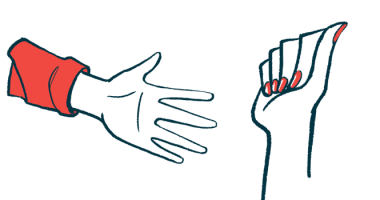Finger Tapping on Smartphone May Measure Parkinson’s Severity

Finger tapping data from Parkinson’s patients using smartphone screens were linked with disease severity in a large-scale analysis that used standard assessment methods.
Given that current Parkinson’s severity measurements are based on clinical observations by trained movement disorder specialists, these findings suggest that approaches such as finger tapping analyses could allow healthcare professionals to make such assessments without the need for clinical visits.
“The approach could pave the way to … remote anonymous screening and diagnosis in the future,” the researchers wrote, noting the potential benefits for both clinicians and Parkinson’s patients.
“We believe that any additional methods that could potentially assist with quantitative assessment of disease severity, without the need for a clinical visit would be beneficial to both the healthcare professionals and patients,” they wrote.
The study, “Parkinson’s disease severity clustering based on tapping activity on mobile device,” was published in the journal Nature Scientific Reports.
Assessing the severity and progression of Parkinson’s disease is essential in both clinical practice and research — and for patients living with the neurodegenerative disorder.
To assess disease severity, its impact on health-related quality of life, and the effectiveness of medications, clinicians and researchers commonly use assessments such as the Hoehn and Yahr rating scale (HY), the Movement Disorder Society’s Unified Parkinson’s Disease Rating Scale (MDS-UPDRS), and the Parkinson’s Disease Questionnaire (PDQ).
These methods consist of rating scales and questionnaires based on interviews and examinations or patient self-assessments. Still, they are primarily dependent on the experience and skills of the trained movement disorder specialist who performs the tests.
As a result, recent research has focused on developing more objective — and quantitative — measures using devices that can capture many subtle, abnormal movements associated with Parkinson’s.
Finger tapping is a task that is easy to perform and has been analyzed for the quantitative measurements of motor symptoms. Because many Parkinson’s patients exhibit poorer coordination and slower motion than healthy individuals, such testing is being explored as a potential assessment tool. However, most studies investigating finger tapping have included relatively small numbers of participants.
mPower is a two-year mobile application-based study using a smartphone to monitor key indicators of disease progression, such as walking, voice, and finger tapping. It is one of the largest mobile Parkinson’s studies, involving more than 8,000 participants.
In this study, researchers based at the National Science and Technology Development Agency, in Thailand, used mPower data to investigate the relationship between finger-tapping tasks on a smartphone and scores from the MDS-UPDRS I–II — for non-motor and motor experiences of daily living — and PDQ-8, assessing health-related quality of life.
“We would like to explore and validate on a large scale that remote PD [Parkinson’s disease] severity assessment via a personal smartphone is feasible and could be performed without using any sensitive information,” the team wrote.
The tapping task involved laying the smartphone on a flat surface and using two fingers on the same hand to alternatively tap two points on the screen for 20 seconds. Data included tapping features such as the number of taps, the location of movements during the taps, the drift in the location of taps from left or right, and the variation in drift. The time between taps, and their variation, also was assessed.
Tapping data consisted of 78,887 tasks performed by 8,003 individuals with Parkinson’s. It included MDS-UPDRS I–II data from 2,024 participants and PDQ-8 scores from 1,334.
For this analysis, participants who performed finger-tapping tasks and had MDS-UPDRS I–II data were selected, which included 1,851 samples. Among these, there were 1,061 samples that also contained PDQ-8 scores.
Computer algorithms analyzed the tapping data and identified three distinct, evenly distributed groups, or clusters, of patients. A statistical assessment found each cluster was distinguished by MDS-UPDRS I–II or PDQ-8 scores, with cluster one being the lowest disease severity and cluster three being the highest.
In particular, the scores from MDS-UPDRS part 2, which assessed the motor aspects of daily living, were strongly associated with cluster three.
“The experimental results show that the tapping features could be one of the tools for quantification of [Parkinson’s disease] severity based on MDS-UPDRS I–II and PDQ-8 scores,” the researchers wrote.
Generally, those in cluster one, with the lowest Parkinson’s severity, had a higher number of taps over baseline, defined as the overall average for each grouped feature. In contrast, this group was significantly lower in the location of movements of taps on the screen and the time between taps.
For patients in cluster two, with the second-lowest disease severity, the number of taps, the location, location drift to the left or right, and variation in time between taps were significantly higher than baseline, while the time difference between taps was lower.
In cluster three, patients with the highest disease severity showed significant increases in locations and time between taps than baseline. All of the other tapping features were lower than baseline.
“Our study provides another evidence that quantitative measurement in a form of finger tapping can complement standard rating scales like MDS-UPDRS for characterizing [Parkinson’s disease] heterogeneity,” the authors concluded.
“Further research on the verification of the results with other datasets or the combination with other features such as gait and memory could also be explored,” they added.








